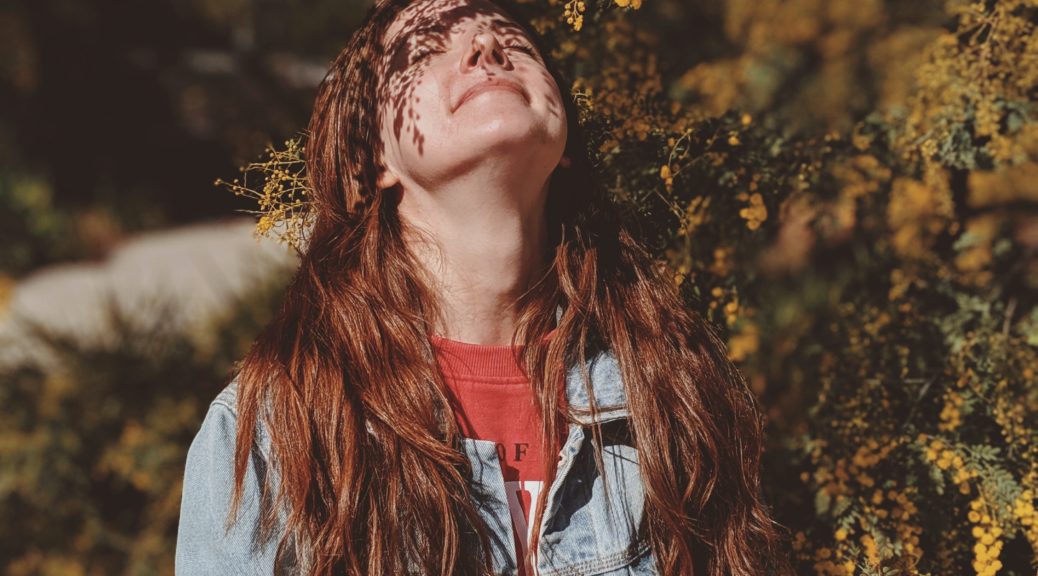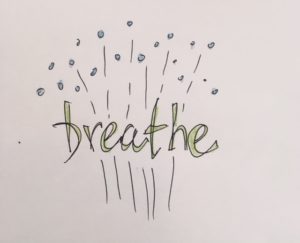
Breathwork takes OH MY WORD practice deeper
I took my life back from the grip of anxiety with two strategies: journaling (in a novel way) and breathwork.
As someone who suffered from anxiety for most of my adult life, I was always on the lookout for strategies that would help me.
I felt like my life had been saved 6 years ago when I started doing ‘heart doodles’ which I would later become OH MY WORD – the insanely simple daily journal to intentionally become who you want to be. With my daily intentional word, I was able to replace my disabling negative thoughts with positive ones I chose. I was in the driver’s seat of my life and my anxiety relegated to the locked trunk. I was free to become the person I wanted to be living with ease and joy.
But that’s not where the story ends.
In the last 2 years I’ve added another strategy or rather I’ve learned a new skill which has taken my daily practice to an even deeper level.
I learned to breathe.
I’d tried meditation it was a no-go
Years ago, doctors and therapists has encouraged me to try meditation as a way to disable anxiety. I tried it but when I’d sit down to meditate my thoughts would ramp up making endless lists, working to solve problems that hadn’t yet happened, chewing on the past and beating myself up over what I could have done better or even trying to figure out what to make for dinner. The chatter was endless.
For someone with anxiety like myself meditation was a no-go.
My old breathing patterns
Like a lot of anxiety sufferers, I was a shallow, chest breather and a breath holder. A double whammy! The way I was breathing was sending my sympathetic nervous system into overdrive activating the fight-or-flight response and filling my body with the stress hormone cortisol. My anxiety driven breathing patterns had put me in a continuous state of fight-or-flight, filled with cortisol and always on the run from tigers, bears and my own negative thoughts.
OK so a little bit of fear is good it can keep us safe but having too much of it is unhealthy for every part of body, mind, heart and spirit.
The new breathing
I didn’t fully understand how powerful breath was until I started doing yoga and learned about the ujjayi breath. It’s also called the ocean sounding breath and when I did it, I was always left with a sense of calm and ease.
How it works
When we engage in deep rhythmic, coherent breathing we activate the vagus nerve, turn on our parasympathetic nervous system and pump the brakes on anxiety and stress. As our physiology returns to its natural inherent state, our minds calm and our hearts open. We’re able to move the breath down from our chest and into our belly, breathing in an intention or a thought we want and breathing out thoughts, beliefs, memories or actions that we don’t want. After breathing this way, we feel good, more equipped to handle stress and anxiety melts away.
Breathwork is an active form of meditation
I did learn to meditate after all. Breathwork is like an active form of meditation. It allowed me to consciously work my breath, bypassing the chattering (monkey) mind to enter a different state of awareness. What most people seek in meditation I was able to get by simply breathing. It allowed me to disconnect from the mind and reconnect with the body, energy and enter a different state of consciousness. This altered state enhanced my healing, clarity, peace and wholeness.
Here are some different breathing techniques to try:
The one I use
The one that I use every day is very simple. I take a long slow inhale in through my nose and exhale through my mouth out making sure the exhale is longer than the inhale. This sends the body into a more parasympathetic state, lowering blood pressure and cortisol levels and it can relieve feelings of depression. I sometimes count in 1-2-3-4- and out 1-2-3-4-5-6. I see a naturopath regularly and I was always telling her how my breathing practice was developing. She would conduct her own examination. She would stop me after one of our super animated conversations and say, “I’m going to take your blood pressure in one minute.” I would start breathing and she would test my blood pressure. She was always amazed at how low it was after just a minute of breathing.
The Ujjayi Breath
The ujjayi breath I mentioned earlier is where you breath in through your nose to a count of 4 – hold at the top for a second – exhale through the nose (from the back of the throat producing an ocean sounding breath) to a count of 4 – hold at the base. Repeat. I often do this lying down with one hand on my belly so I can feel the rise and fall and one hand on my heart.
Box Breathing
Start by releasing all the air from your chest and hold your breath for 4 seconds, then breathe in through the nose for 4 seconds, the hold your breath for 4 seconds, then exhale out through the nose for 4 seconds. Repeat for 5 minutes to feel the effects.
Relaxing breath from Dr Andrew Weil
Relaxing breath also known as 4-7-8 breath slows the heart rate and brings consciousness to the present moment. It also teaches the body how to take in less, release more and create space between inhales and exhales. By creating space between stimulus and response, this breath has a practical application in the stressful moments we encounter on a daily basis.
How to do:
Start by releasing all the air from your chest and inhale through the nose for 4 seconds, then hold your breath for 7 seconds, then exhale out of the mouth for 8 seconds. Repeat the cycle up to 4 times.
Coherent breathing from Stephen Elliot
While our natural tendency is to breath at a rate of 2 or 3 seconds per breath, this controlled and conscious breathing which is common practice within yogic traditions) slows our inhales and exhales down to 4 seconds, then 5 seconds and beyond. The intention of this breath is to increase heart rate variability which calms the body and can affect heart rate, digestion, concentration, vitality, sleep and stress response.
How to do:
To start, focus on the natural rhythm of your breath to obtain a baseline length of each inhale and exhale. Then for 1 minute breath in for 4 seconds an exhale for 4 seconds. Then repeat for 5 seconds, then for 6 second and if you are able gradually expand to 10 seconds. Whatever elongated breath you work up to maintain it for 5 minutes to start and work your way up over time to 20 minutes.
Breathwork is available to everyone
Breathwork is available to everyone and can be very healing and restorative for people who dealing with stress, anxiety, fear, grief, sadness, anger or insomnia. But it’s also nourishing for anyone who is looking to go deeper in their search of love, peace, gratitude, clarity, connection and insight in their life.

AAAAAhhhhhhh……..
OH MY WORD tip:
Use breathwork to deepen your OH MY WORD practice. When you’re sitting at your desk, stuck in traffic, in line at the grocery store or at the bank. Breathe in your intentional word and breathe out your word. This moves your intention that much deeper into your mind and body.

Does anxiety and negative thought stop You from being the person you want to be and following your dreams? OH MY WORD is a science based, 5 minute, one-word daily journal that allows you to take charge of your life, become the person you want to be and live with joy and fulfillment.
ONE WORD CAN CHANGE YOUR LIFE.
Buy OH MY WORD here:
25 Replies to “Breathwork takes OH MY WORD practice deeper”
Breathing keeps us intact. It is always safe to say that one way to be able to cope up with your problems is to breathe, in this way your body will absorb more oxygen thus making your brain work better.
Breathwork is available to everyone and can be very healing and restorative for people who dealing with stress, anxiety, fear, I am a living testimony to this. Breathwork really helps especially when fresh air(oxygen), that’s why wearing nose masks up and down isn’t my thing.
thanks for the info in this trying times we really do need some breathwork. very helpful
I agree. After a few minutes a sense of calm is felt in mind and body.
This breathe work is a very effective type meditation. It helps you clear your mind and relieve your stress.
I’ve developed stress , depression and anxiety due to this pandemic. I do breathing exercise after a quick work out and it really helps a lot. My body and mind is fully restored.
Amazing practice for stress relief and it’s great it can be executed anytime, anywhere. I find I fall asleep right away when I focus on my breathing patterns. Thanks for listing the different types of breathwork and their health advantages for everyday life.
I also did meditation and it is a hard thing to do. I think taking a deep breath is not just science but it can be more. For one it makes you think before you do and say something. A pause is always good.
Breathwork is a good technique especially for those who can’t meditate. I will be taking it up.
Breathwork is a great practice for those who can’t meditate. For me it has become a very effective active meditation.
Much like you, I suffered anxiety for quite a while. Luckily, I found yoga to be very helpful and has saved my life.
Yoga is something I have added to my self care practice. I have been practicing for 2 years and I too find it very helpful:)!
It’s the first time I’m hearing about the ujjayi breath. Suffice to say I’m pretty impressed
I have never attached much seriousness to how I breathe. That will definitely change from now on.
Amazing breathing technique to help with stress and anxiety. I needed to read this!
The technique I am most interested in trying is The Ujjayi Breath. I hope it will be helpful.
Yes:) the ujjayi breath is very simple. It is the breath I use in my yoga practice.
In a way, controlled breathing is much akin to meditation. Practicing it with yoga yields even better results.
The ability of breathwork to heal has always been overlooked. I can confirm from experience that it’s very therapeutic.
Thanks for making Oh My Word journal available for purchase on so many platforms. That makes it easily accessible for people who need it the most.
Yes:) its very helpful in easing anxiety and cultivating more joy in your life. It also puts you in charge of your life and the person you are today and want to beocme.
I am interested in Coherent breathing from Stephen Elliot. That’s one I have to try for myself.
It’s awesome. This is the breathing technique that triggered my entry into breathwork!
How many times a day should we practice these breathing exercises? Is there a limit?
There is no limit. I do them whenever I feel my heart start to race, or I’m in a stressful situation or I’m standing in line at the grocery store. IUt just takes a few breaths to settle and regain equilibrium.